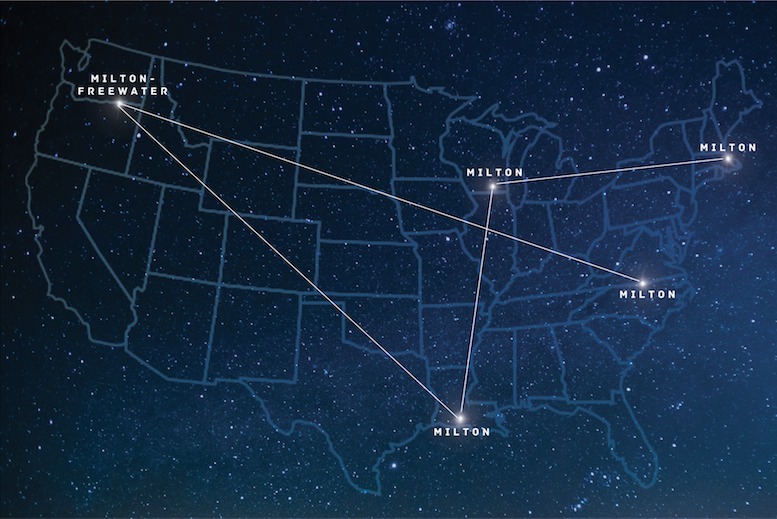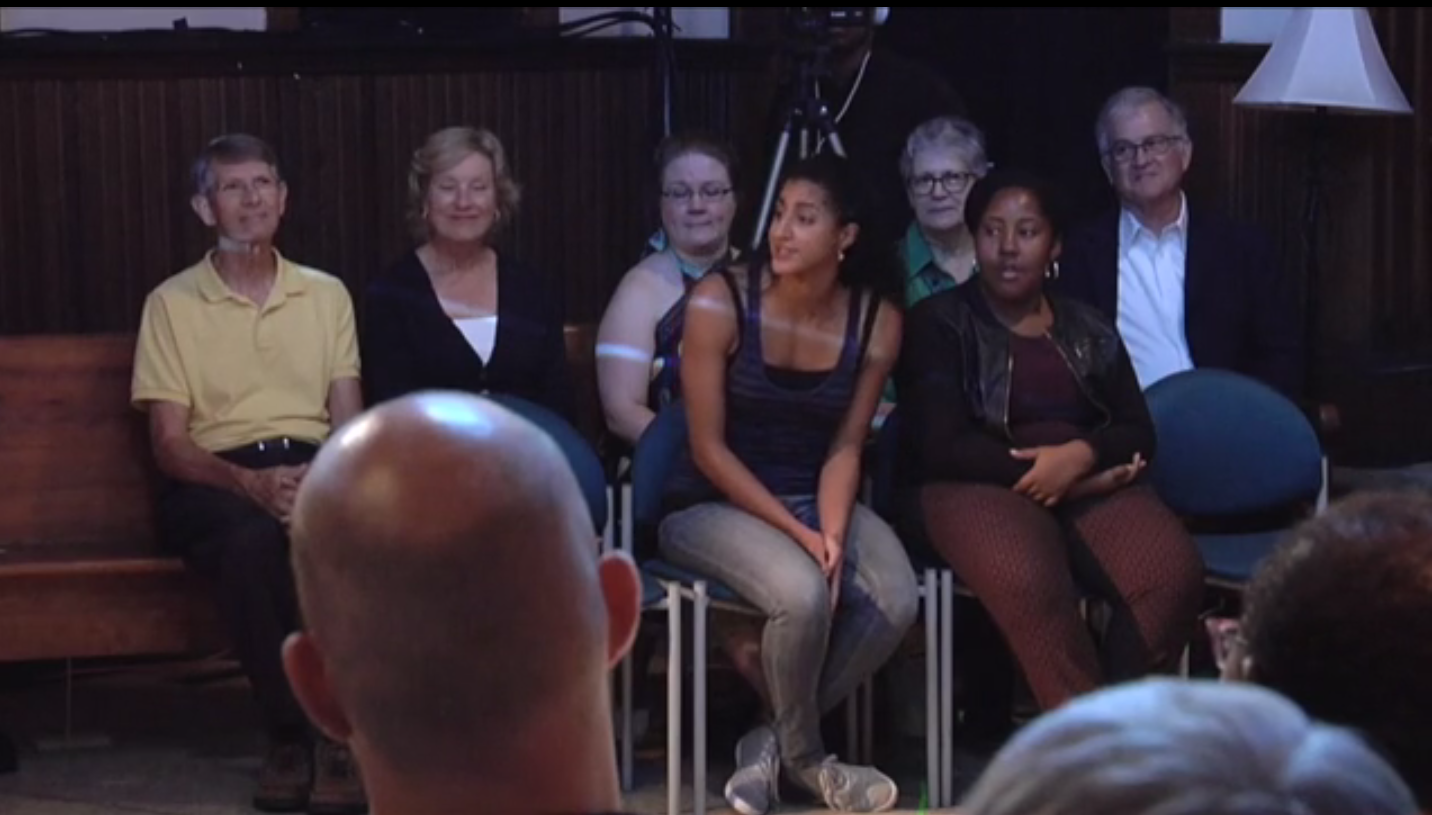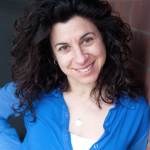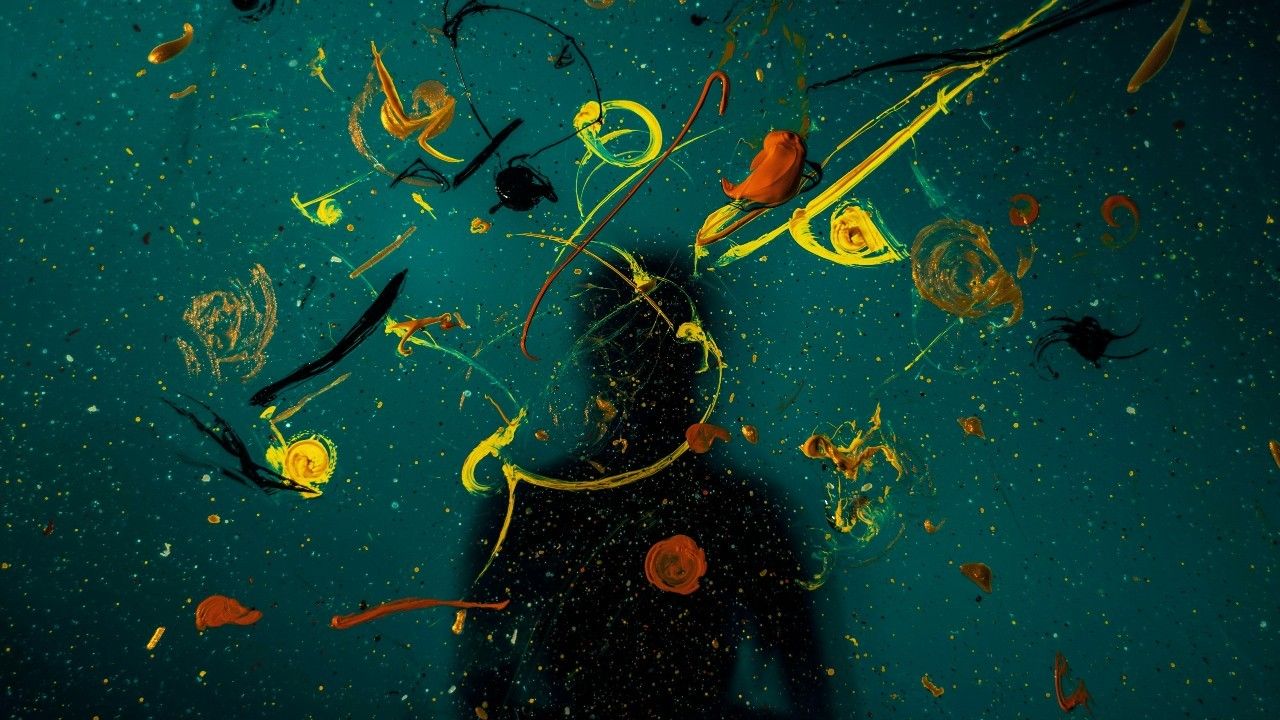Theater-makers Katie Pearl and Lisa D’Amour — the duo behind the performance umbrella PearlDamour — first met in 1996 in Austin, Texas, where Pearl was the resident director at Physical Plant Theater and D’Amour was finishing her MFA. They shared an interest in site-specificity in art. The following year, they embarked on their first collaboration, “The Grove,” a site-specific 14-hour long installation designed to draw commuters’ attention to an overlooked patch of trees along one of Austin’s busiest thoroughfares. The pair has continued their creative partnership ever since, even as they continue their individual pursuits (Pearl finishing her MFA at Brown University, while D’Amour tended to the New York debut of her play “Airline Highway.”)
PearlDamour’s work is interdisciplinary — crafted by extensive collaborations with artists in other fields — and largely focused on community. Their performances inspire a breaking away from linear narrative into a reinvigorating and re-imagining of the theatrical event.
For the most part, PearlDamour has worked in cities such as Austin, Minneapolis, New Orleans and New York. Their “How to Build a Forest” — billed as “part visual art installation and part theater” — premiered at The Kitchen in NYC in 2011. The piece invited audiences to witness the construction and dismantling of an artificial forest over the course of an eight-hour performance. The piece was inspired by the loss of more than 100 trees on a D’Amour family property in New Orleans during Hurricane Katrina.
More recently, their curiosity led them outside of the “urban bubble” into the development of work in and with rural communities. For the past two years, they’ve been traveling the country working on “Milton,” a theater piece and community engagement experiment. They’ve visited five different Miltons — in Massachusetts, North Carolina, Louisiana, Wisconsin and Oregon — interviewing people about their lives, towns, and what it means to be American. PearlDamour is turning those conversations into interactive theater pieces in each of the selected towns, having already mounted one in Milton, North Carolina, in the fall of 2014. They plan to continue their investigation at least through 2017.
Extended Play Editor Ian Daniel spoke to Pearl about her creative history with D’Amour and the things the duo has learned about Americans — and themselves — in the making of “Milton.”
IAN DANIEL: I spoke to you and Lisa last year about “How to Build A Forest” and your focus on making that work to be open-ended enough to hold lots of different conversations, to let people have their own experience. How did that performance-making experience carry over into creating a piece in and about Miltons across the U.S.?
KATIE PEARL: One thing that we had really loved about “How to Build a Forest” was the way it invited audiences to be part of the experience throughout the eight hours. There’s a kind of a community that forms. But what do they take back out with them into the world? So that was what was on our minds with the “Milton” project — how can a project actually increase that connection, that impact?
“We thought, maybe we should just make a project that requires us to go out into this country to places we’d never have reasons to go to, talk to people we’d never have reason to meet, and find out what it means to people to be an American.”
And this was during the election of 2012, so all of this stuff is being thrown around about, “What’s an American? What’s a good American? What’s a bad American? You are an American. You aren’t an American.” We started acknowledging how we have lived and worked in big cities — for and with people who are largely just like us, who share our background, share our economic status, for the most part share our values — and we acknowledged that we didn’t have a very complex or deep relationship to the word “American.” So we thought, “Well, maybe we should just make a project that requires us to go out into this country to places we’d never have reasons to go to, talk to people we’d never have reason to meet, and find out what it means to people to be an American. And also as we go, we’re going to find out a ton about ourselves, we’re going to find out a ton about them, and then we’ll make a piece based on those experiences.”
So that was an enormous question that we had to contain in some way, and so we decided to choose five towns that shared a name to provide a kind of false structure. We Googled “most commonly named cities,” and “Milton” was the name that most woke up our imaginations. It reminded us of John Milton. It sounded like a person — I had an Uncle Milton. And after having spent so long thinking about the ecosystem and how things travel and move through our world while working on “How to Build A Forest,” we loved the idea of focusing on the individual in relationship to a larger system. Can we look at the vastness of the country and at the idiosyncrasies of one tiny individual? And what will that tell us? And what will that yield? So, that’s kind of where we started. The idea that the points of each of these Miltons on the map of the United States could become a new constellation that would tell the story of what it feels like to be an American in 2014. And so that became a really iconic symbol for us.

IAN: How did you approach the investigation process? Did you know much about each town or did you just go in cold and start to talk to people?
KATIE: We were so devastatingly naive when we started. We spent hours, days trying to think of questions and then rehearsing how we would ask them. We tried to invite a group of people to come watch the sunset with us, and while we were watching the sunset we were going to throw them a bunch of questions. I’m just going to tell you all of our failures now. The first time we went into a town it was Milton, Massachusetts, which is the easiest one to get to, because we can drive to it from where I’m living in Providence right now. We thought we could walk into a Starbucks and sit down with somebody and say, “Hey, can we ask you some questions?” And they’d say, “Oh, sure! Of course! Yes! What a fascinating thing. I would love to have a conversation with you.” Which did not happen. We went to the library, and we had made these little notes from PearlDamour just saying, like, “Hey, PearlDamour is down in the cafe, and when you’re taking a break, come talk to us about x, y, and z,” with a little sky insignia. Nobody came.
The other beginning point for us in Milton, Massachusetts, was that I was in a Theater of the Oppressed workshop in Washington, on an island off of the coast of Seattle, and I was being put up by a family. And I was telling them that I was about to launch this project called “Milton,” and the woman I was staying with said, “Oh my god. I grew up in Milton, Massachusetts.” And that happened all the time throughout the project, like “Oh my god! I know somebody who knows somebody who lives in Milton.” And so that woman’s mother set us up with the Unitarian church. And the Unitarian church minister gathered a group of people to have a story circle with us after church one day, and that was really our first way in.
And even so, that started with an almost disaster. Lisa and I really are interested in questions like, “Where do you think the mystery is in your life?” And, “Do you think it’s possible to ever really know somebody else?” And what we didn’t know is that you can maybe get to those questions, but you can’t lead with those questions. And so we started the story circle, and we laid out that question about mystery. And this woman sort of pushed her chair back, and she said, “I’m sorry. I misunderstood what this meeting was about. I thought you wanted to know about the history of Milton, so I’m going to excuse myself.” And it was fine, it was friendly, and we totally recovered. But it was such a good lesson. That the first question always needs to be, “How’d you get to Milton? How’d you end up living here?” And then that in itself will start to open up the door to these other questions.
If I meet somebody by chance, I’ll say, “I’m actually in town because I’m a theater-maker, and I’m traveling to five small towns named Milton across the United States. And I’d love it if you had time to sit down with me and I could ask you some questions.” And then when somebody sits down with me, it tends to go like this — “When we sit down with people, we like to ask them four questions. Do you want to know what they are?”
IAN: Yes.
KATIE: And then the person will say yes, like you did. And I’ll say, “So they start pretty basic, and they get pretty philosophical. The first question is, ‘How did you get to Milton?’ The second question is, ‘If there were one thing you could change about the world, what would it be?’ The third question is, ‘Do you have advice for future generations?’ And then the fourth question is, ‘Why do you think we are here on this earth?'” And they’ll have whatever response they have. And then I’ll say, “They’re big questions, I know, but let’s just start with the first one and then we’ll see how it goes, and you can answer any or all of them, but why don’t you just start by telling me how you got to Milton.” And then we’ll talk about that for a long time, and then I’ll say, “So, you want to go for another one?” And they’ll be like, “Okay, yeah, remind me…” And we’ll usually work our way around to all four. But it’s taken a good year and a half to get to that level of comfort. Of asking and not feeling apologetic about it.
IAN: Were those questions strict to your process and used in every Milton? Or did you find that you also needed to lead with your instincts, if you met an interesting person you’d allow it to be more open-ended?
“When we do the show in each town, we want to orient to that Milton specifically. There are parts of it that will remain the same and parts that will shift for each location.”
KATIE: Sometimes we really try to stick to those questions, because we have been amassing so much material that we actually are scared to keep amassing that much. And sometimes we have a whole interview with somebody and don’t ask any of those questions, because their life story is so interesting, or they represent a particular point of view. Often, we’ll throw in that question about, “What does the word ‘American’ mean to you?” It’s become a helpful template and a structure, but it’s not one we stick to all the time. When we do the show in each town, we really want to orient to that Milton specifically. There are parts of it that will remain the same, and then there’s parts that will shift for each location.
A lot of what we learned, even in North Carolina for example, is that people who look like you are way more likely to feel comfortable talking to you. And you’re way more likely to get access to them. In North Carolina, the town is 50 percent black and 50 percent white. And we worked long and hard to build some trust with the black community, so that they would talk to us and share stories with us. We did that largely by going to their church services and just inputting ourselves in their community, letting them know what was going on, and doing that again and again. The feedback we got from them was that that really made a difference, when we would come and go to their church. But even so, there are so many layers of protection that that community has against sharing different aspects of their actual experience that I don’t know that we were ever able to get to the bottom of some of these really deep personal truths with them.
And then in Massachusetts, I think it’s just a much more analytical town, and so we get a lot of analysis about how things are. And people just move faster. They have a quicker tempo. In Oregon, you know, people are… It’s so expansive there, and it’s a cowboy, farming town where people are happy to sit and share their largely conservative views. Lisa and I felt like being two basically nice-looking white women really enabled our conversations. Because people didn’t feel threatened by us.
IAN: Did you run into questions about your motives as artists exploring their towns? Surely there are people that think it’s great — the interest, the exposure — and other people that think the attention could be negative or exploitative.
KATIE: I think people were very concerned about how their town was going to be represented. And the first level that we needed to get through was these cheerleading sessions for how great their town was. And there was distress. We heard later, even in little, tiny Milton, North Carolina, they were worried that we were coming in to do some sort of scam. I don’t know what a theater scam would look like. Because it’s rare — it’s rare for somebody to come in and say, “We don’t actually want anything from you. We just want to have conversations and talk. It’s a bizarre thing in today’s world. It really is. And so, yeah, I think that people do meet it at first with some distrust.

IAN: How do you move from your personal conversations with townspeople into the conceptualizing phase of the live piece?
KATIE: We knew that we didn’t want to use people’s interviews word for word as script. Both because we didn’t want them to feel like they were going to be put on the spot and used in that way, but also because we felt like the conversation we wanted to have was much bigger than, “Oh, here’s a story about this town. Oh, all these stories equal a quilt of America.” Which is sort of the bad version of what this could be. And we started recording all of the visits that we took by making lists that we called our “sometimes lists.” When we would go to towns, we would start to try to track the day — “Sometimes you’re served a glass of chocolate milk. Sometimes someone tells you a story of their family farm that got bought out by the government. Sometimes…” So we started compiling this huge list that tracked all of our experiences. And at the same time, we were compiling all of these interviews. And then Lisa would print out these hundreds of pages of transcriptions and stare at them and be totally frozen. Like, how is she going to turn this into a script when everybody we talk to then becomes so invested in their story?
As the piece took shape, we decided to make the spine of the play a list built on all of these sometimes lists, so that it would really come from the perspective of an outsider’s experience coming into a town. And then sometimes the list would bubble into a longer story about a person we met or something in that town. And then out of that longer story, an actual voice would emerge into the room of either that person or somebody who’s part of that story. The audience is set up in a sort of loose circle of seats, and there’s only like 80 or so people in the audience. We kept it really small on purpose. We wanted it to feel like a community gathering.
“The goal was to bring all five Miltons into one room. We might have radically different ideas about the right way to live, and yet we’re still sharing this space and sharing this experience, and aware of that.”
For example, we hear one man in Oregon talking about this kid who had never had a job, and how he sent him to Walmart to get a job, and that really changed this kid’s life. Or another time we hear the voice of a couple from Wisconsin, and I’m asking her what it feels like when God speaks to her, and then Lisa says, “Wow, that actually sounds like what it feels like when I get inspiration for my plays.”
The goal for all of these strategies was to bring all five Miltons into one room and to make people feel the definition of America that we’ve started to understand, which is that it’s a huge country built for people to live in side-by-side and have many points of view. That that’s happening in this room right now, and we might have radically different ideas about the right way to live, and yet we’re still sharing this space and sharing this experience, and aware of that. And then that leads into the conversations with the audience.
IAN: Who ends up in the audience? Did any of the people that you interviewed attend? If so, did you get any feedback from them about how they felt being a part of the performance?
KATIE: One of the interesting revelations for me about doing this play is that we rehearsed it in New York, and at the end of our rehearsal process we had invited showings, so we did get some audience in there. And it was… fine. But when we did this show in North Carolina with and for the audience that it was made for and from and about and by, it was like the DNA of the show changed. We did five shows, and by the end of the show, the actors had been in town for maybe a week. Because it’s so small, they had met so many of the people that get mentioned by name in the show. And so they then started getting comfortable enough to try to improvise around. Like when they mention the earrings that Taco made, they’re like, “Stand up, Taco!” It started to become a really alive moment. Or there was this moment when the actress Helga Davis is describing looking down and seeing the grave of Miss Patsy’s dad, and then Miss Patsy was sitting next to her, and she was crying, and Helga was holding her hand. Or there’s this one woman named Nancy Hughes, who is 87 years-old. And she’s worked her entire life, like so many jobs, and now her job was to clean the post office on Sundays. And when we were doing the job section, and the actor says to somebody else, “Your job is to clean the post office on Sundays, because Nancy Hughes needs to rest,” and when Nancy was in the audience she was, like giggling with delight. They just feel so… seen.
IAN: What about your personal discoveries? Did you have an opinion about America that changed throughout the process of traveling, talking to people and making this work?
KATIE: I think it’s a couple different small, growing awarenesses. One is that I didn’t realize how much of this country is still a farming country, is still agriculture. This country is just so big, and the environmental concerns in the different parts of the country are so different. It’s so weird that we have one government. It’s so weird that we’re one country.
I’ve also been really struck by the need for communities, and the ways communities persist or try to keep finding themselves. I was not raised going to church. I didn’t go to a public school, and we didn’t interact with the neighbors. My family was by ourselves a lot of the time, and I didn’t realize how vital a school can be in terms of making an identity for a community and giving people this gravitational center to move around. Or the value of a church, which maybe has to do with god and religious beliefs, but it also has to do with providing a structure and a framework for people to orbit within. I hadn’t really known that before. Probably the biggest realization for me is that I, like I think most educated people in larger cities, assume that people who are less educated and who live in small towns are less self-reflective than other people. And the majority of people I meet — no matter who they are or what they look like or how educated they are — when given the chance, they reveal that they are super self-reflective and that they think a lot about life and the government and the country and each other.
And I think I’m also learning through this process how prevalent racism still is. Everywhere. Our country was built on it, and it is still part of what makes this country function. It’s crazy, and it’s been humbling and upsetting. Not virulent racism, necessarily, but it’s just part of — it’s structural.

IAN: Do you think this work pushes people toward an empathy or a deeper understanding of America’s diversity on some level?
KATIE: It does. And being within the play really helps people be in a state of curiosity.
IAN: Can you speak to the importance of the communal or community in your work?
KATIE: Welcoming people in has always been the first step of almost every show. We know that the worlds that we’re creating are so strange, or can be strange, and we want people to feel comfortable within them so that they can experience them. So we put a lot of thought into the doorways that people can move through to be there with us. I think, for me, this project has made me want to dive into understanding how theater and performance and conversation can actually become the same thing. Some of those things we did with “Milton,” but I want to keep investigating that, because conversation is something that is eroding in our culture, and I think the impulse to even make a play in the first place is the same impulse as wanting to talk about something. You want to have a conversation, but the usual form of plays doesn’t actually allow for a conversation to happen, so how can our plays actually require that conversation to happen? I think once you’ve got conversation, you start having a community.
I think a lot about something Michael Rohd said. Michael Rohd started a company long ago in Oregon called Sojourn, and now he has this center in Chicago at Northwestern University that’s about theater and civil practice, and he does a ton of theater consulting work with city institutions. He said that, in his opinion, what theater artists have to offer needs other communities in our process, as in, that’s what these city governments are really in need of from our end. What is our process? How do we get from A to B? How do we develop? And I really bought into that. Doing this project made me realize that’s part of it, but also the product is super important. If we had simplified down, or if we had said, “You know what? It’s just North Carolina, this tiny town. We’ll rehearse for a week, we’ll put something up there, it’s not a big deal, they’ll love it. They don’t know. They’ll love it!” If we had done that, we would have missed out on a certain kind of impact that we had by presenting something that was so clearly, deeply thought through and deeply worked through, that showed a lot of respect to a town that had showed us a lot of respect by their welcome and their hospitality.
IAN: I’m curious whether or not you’ve seen deliverables in terms of your work’s impact on the Miltons you’ve visited?
KATIE: The only town that really makes sense to talk about in terms of this is Milton, North Carolina, because that’s where we really brought the project through the whole cycle. One of the things going on with their town is that it’s becoming invisible, because it’s on this stretch of highway, and the downtown is only three blocks long. People just rush through it on the way to the racetrack. So we worked with them to make this street fair weekend happen. And it was this wild success. This is a town of only 200 people, so the fact that over the course of that weekend, 500 people drifted through town and hung out — everyone was very excited about it.
In my experience, and based on what people expressed to me there, the relationship between black and white Miltonians is incredibly amicable, very mutually supportive, but also deeply socially divided. So the two communities just don’t tend to mix. The churches are different. The social events are different. And I think that they really are living out the legacy of being a segregated southern town.
When we were trying to have these meetings after the play about “how can we move forward with you,” or “how can the town take what we’ve done here and move forward” — it took a huge amount of effort to bring black people into those meetings. And now the sense is that, like as the street fair committee planning moves forward, it just sort of is by default the white community doing it. And it kind of forgets, in a way, to make sure the black community is also invited. Or they just don’t have the time or the awareness to make the same kind of effort that we did. So we’re kind of standing back. I mean there’s nothing that we can really do, but we’re curious — we’re hopeful — that the bridge that we started to build with those two communities when we were there will continue.
IAN: Where’s the next performance?
KATIE: The next one is going to be in Milton-Freewater, Oregon, that’s where we’re focusing our interviews for 2016. In Louisiana, Wisconsin and Massachusetts, we’re only in the stage of the project where we’re having individual or small group conversations with people.
IAN: Will you bring this to New York at some point?
KATIE: Yeah, we think so. We’ll have to really think about how the play needs to change in order to be with a New York audience, but really our priority at the moment is to get it to all of the Miltons, because we feel like we need to finish what we started. And we have a responsibility.
*”Milton” is performed by Helga Davis, Vella Lovell, and Mike Shapiro. Sky video: Jim Findlay. Sound and Composition: Brendan Connelly. Dramaturgy/engagement: Ashley Sparks
Authors
-

Katie Pearl is a collaborative theater artist and author of new performance works for both traditional and alternative spaces. She is co-Artistic Director of the OBIE Award winning PearlDamour, an interdisciplinary company she shares with playwright Lisa D’Amour. Recent work blends visual art, theater, and casual get-togethers to explore the role of live conversation within performance.
View all posts -

The Civilians is a company that creates new theater from creative investigations into the most vital questions of the present. Through a number of artistic programs, the Civilians advances theater as an engine of artistic innovation and strengthens the connections between theater and society. An artist-led company, the Civilians creates and produces new theater and pursues its artistic mission through programs serving artists and the public. The company’s work is grounded in investigative theater, an artistic practice rooted in the process of creative inquiry that brings artists into dynamic engagement with the subject of their work. Artists look outward in pursuit of a question, often engaging with individuals and communities in order to listen, make discoveries, and challenge habitual ways of knowing. The ethos of investigative theater extends into production, inviting audiences to be active participants in the inquiry before, during, and after the performance. Since its founding in 2001, the Obie Award-winning company has supported the creation of 14 original shows, and its work has been produced at many theaters in New York, nationally, and internationally. Last season saw two highly successful shows: "Mr. Burns: a Post-Electric Play" at Playwrights Horizons, which was included in eight Top 10 of 2013 Lists, and "The Great Immensity" at The Public Theater. The Civilians’ work has been published by Dramatists Play Service, Oberon Books, Ghostlight Records and Playscripts, Inc.
View all posts








